2010 TOYOTA AVALON parking brake
[x] Cancel search: parking brakePage 2 of 476

TABLE OF CONTENTSIndex
2
AVALON_U (OM41437U)
1-1. Key informationKeys ..................................... 22
1-2. Opening, closing and locking the doors and trunk
Smart key system................. 24
Wireless remote control ....... 36
Doors.................................... 40
Trunk .................................... 46
1-3. Adjustable components (seats, steering wheel,
mirrors)
Front seats ........................... 50
Rear seats ............................ 53
Driving position memory system ................................ 55
Head restraints ..................... 59
Seat belts ............................. 61
Steering wheel ..................... 68
Inside rear view mirror.......... 70
Outside rear view mirrors ..... 72
1-4. Opening and closing the windows and moon roof
Power windows .................... 74
Moon roof ............................. 77
1-5. Refueling Opening the fuel tank cap ..................................... 80 1-6. Theft deterrent system
Engine immobilizer system ................................ 83
Alarm .................................... 85
Theft prevention labels (U.S.A.) ............................... 87
1-7. Safety information Correct driving posture ......... 88
SRS airbags ......................... 90
Front passenger occupant classification system ......... 103
Child restraint systems ....... 109
Installing child restraints ..... 113
2-1. Driving procedures Driving the vehicle .............. 124
Engine (ignition) switch (with smart key
system) ............................. 133
Engine (ignition) switch (without smart key
system) ............................. 137
Automatic transmission ...... 140
Turn signal lever ................. 145
Parking brake ..................... 146
Horn .................................... 147
2-2. Instrument cluster Gauges and meters ............ 148
Indicators and warning lights ................................. 151
Center display..................... 154
1Before driving
2When driving
Page 12 of 476
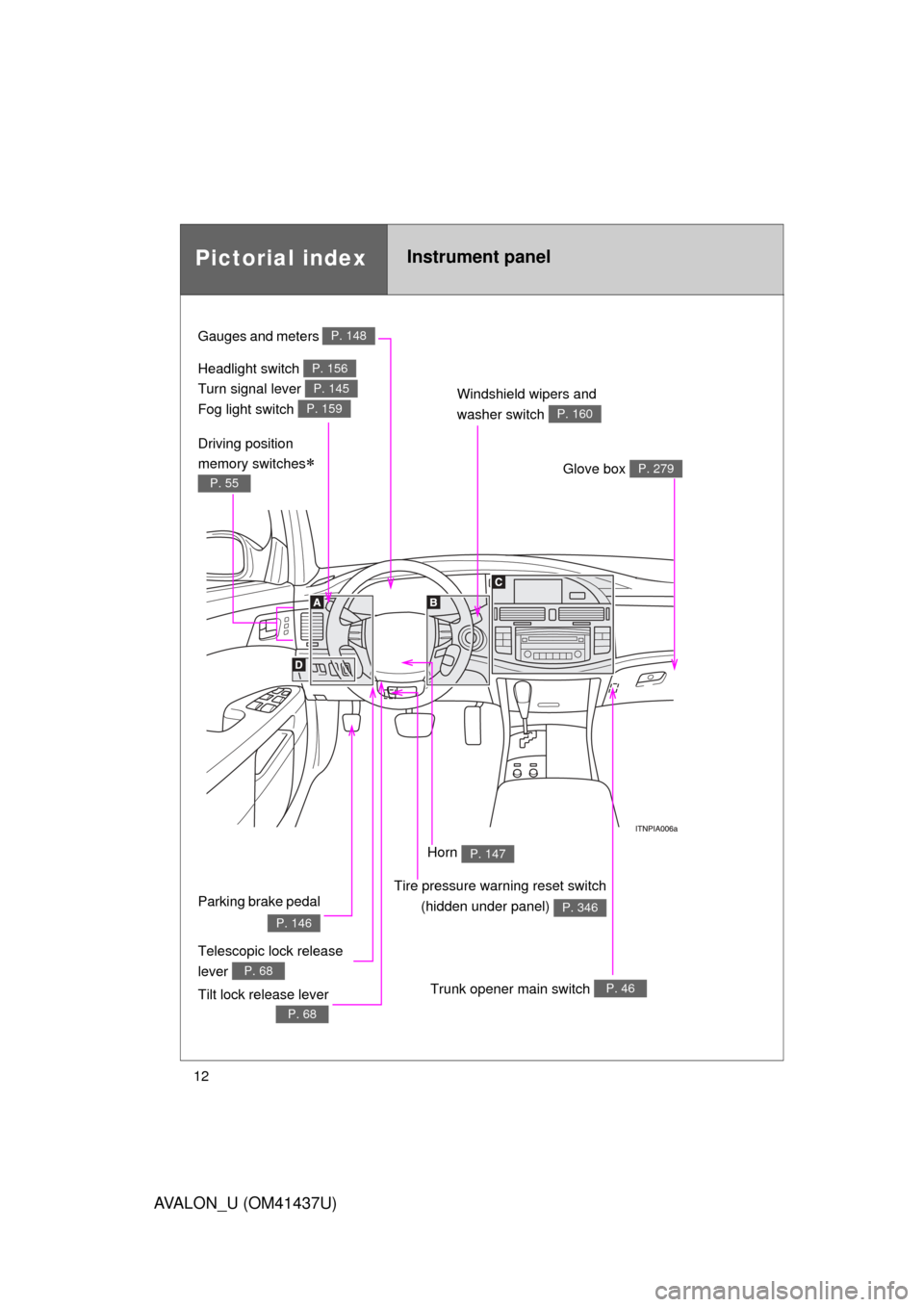
12
AVALON_U (OM41437U)
Pictorial indexInstrument panel
Headlight switch
Turn signal lever
Fog light switch P. 156
P. 145
P. 159
Gauges and meters P. 148
Windshield wipers and
washer switch
P. 160
Trunk opener main switch P. 46
Glove box P. 279
Telescopic lock release
lever
P. 68
Parking brake pedal
P. 146
Tilt lock release lever
P. 68
Driving position
memory switches
P. 55
Tire pressure warning reset switch
(hidden under panel)
P. 346
Horn P. 147
Page 123 of 476
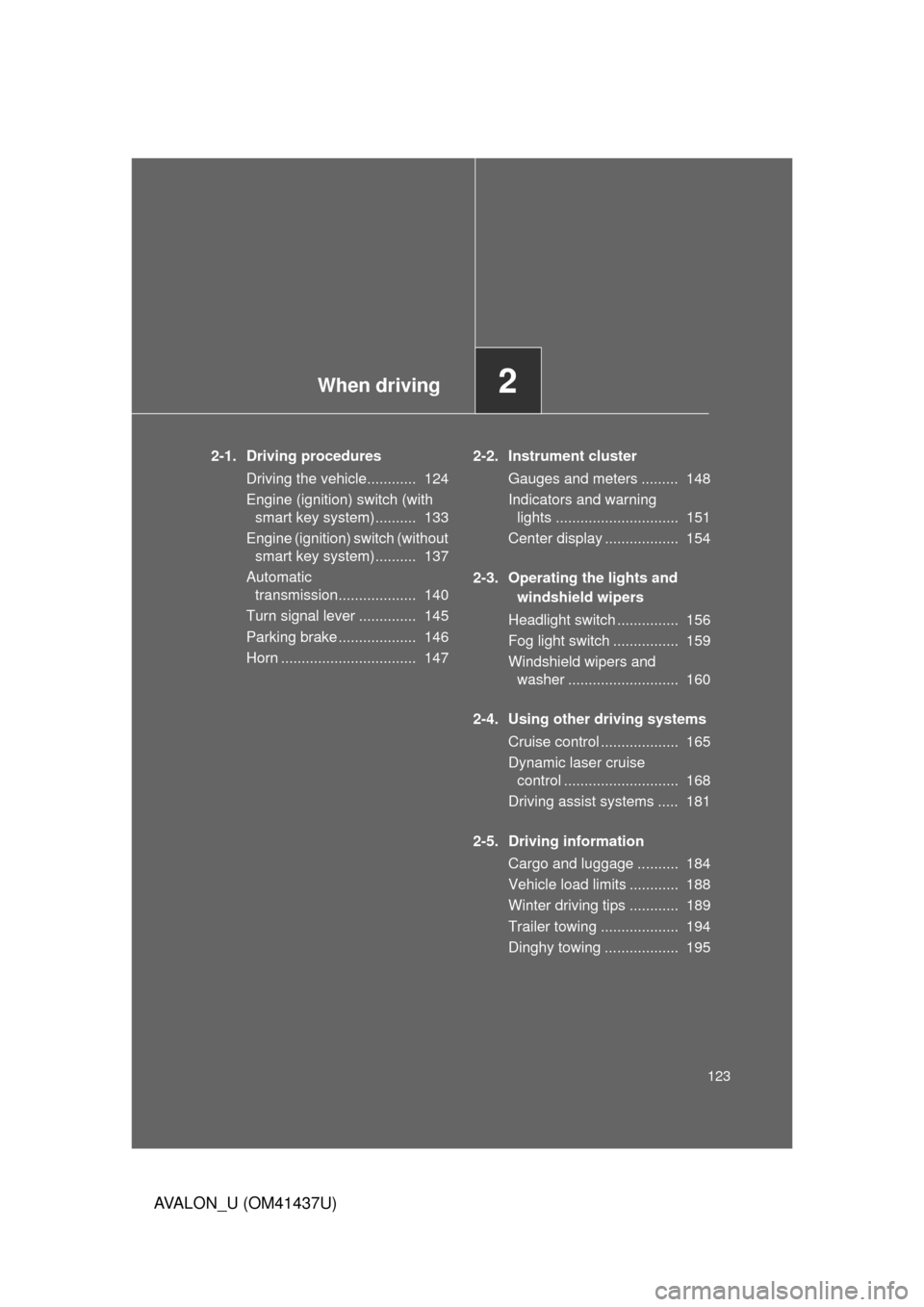
When driving2
123
AVALON_U (OM41437U)
2-1. Driving proceduresDriving the vehicle............ 124
Engine (ignition) switch (with smart key system).......... 133
Engine (ignition) switch (without smart key system).......... 137
Automatic transmission................... 140
Turn signal lever .............. 145
Parking brake ................... 146
Horn ................................. 147 2-2. Instrument cluster
Gauges and meters ......... 148
Indicators and warning lights .............................. 151
Center display .................. 154
2-3. Operating the lights and windshield wipers
Headlight switch ............... 156
Fog light switch ................ 159
Windshield wipers and washer ........................... 160
2-4. Using other driving systems Cruise control ................... 165
Dynamic laser cruise control ............................ 168
Driving assist systems ..... 181
2-5. Driving information Cargo and luggage .......... 184
Vehicle load limits ............ 188
Winter driving tips ............ 189
Trailer towing ................... 194
Dinghy towing .................. 195
Page 124 of 476
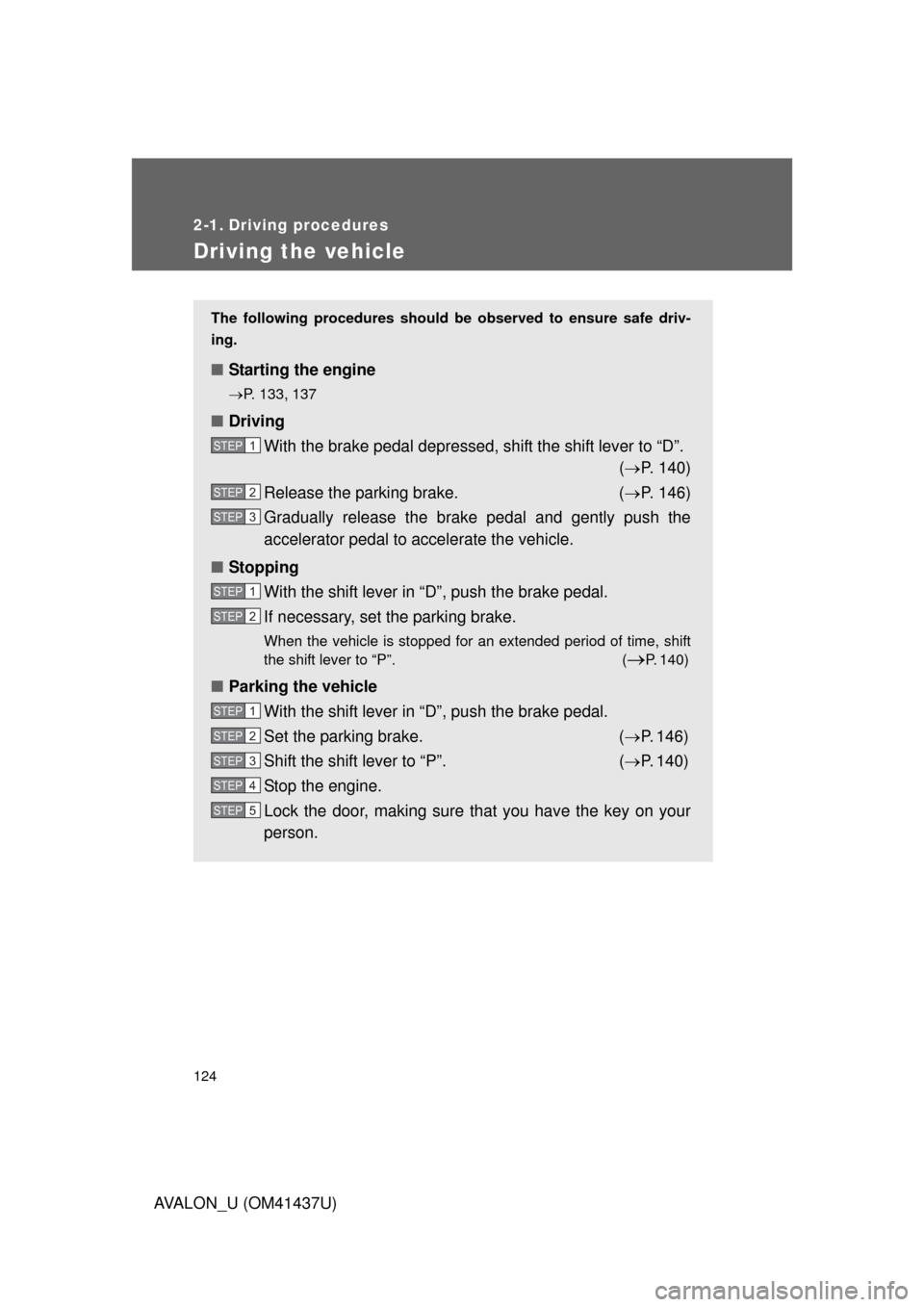
124
AVALON_U (OM41437U)
2-1. Driving procedures
Driving the vehicle
The following procedures should be observed to ensure safe driv-
ing.
■ Starting the engine
P. 133, 137
■ Driving
With the brake pedal depressed, shift the shift lever to “D”. ( P. 140)
Release the parking brake. ( P. 146)
Gradually release the brake pedal and gently push the
accelerator pedal to accelerate the vehicle.
■ Stopping
With the shift lever in “D”, push the brake pedal.
If necessary, set the parking brake.
When the vehicle is stopped for an extended period of time, shift
the shift lever to “P”. (
P. 140)
■Parking the vehicle
With the shift lever in “D”, push the brake pedal.
Set the parking brake. ( P. 146)
Shift the shift lever to “P”. ( P. 140)
Stop the engine.
Lock the door, making sure that you have the key on your
person.
STEP1
STEP2
STEP3
STEP1
STEP2
STEP1
STEP2
STEP3
STEP4
STEP5
Page 125 of 476
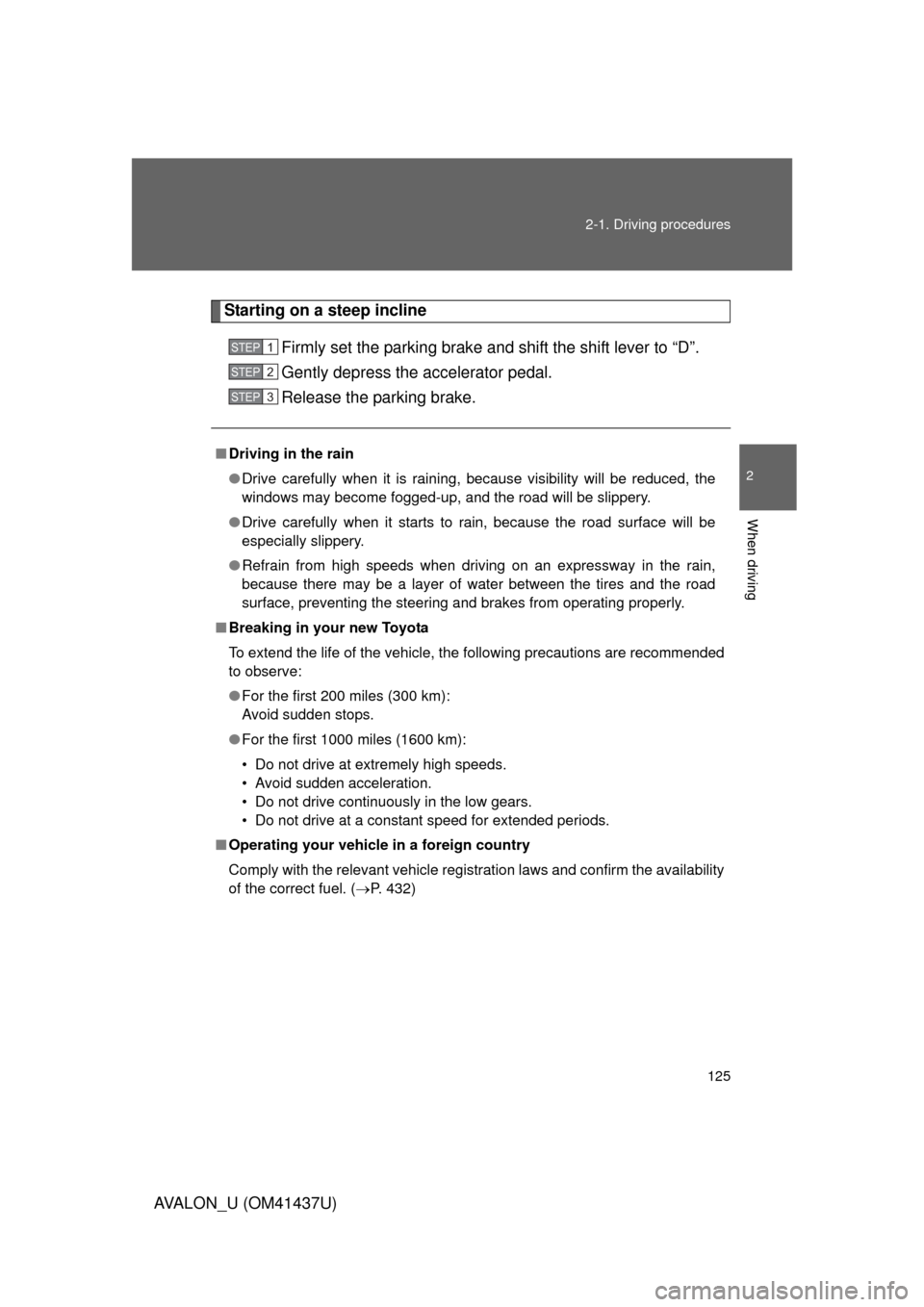
125
2-1. Driving procedures
2
When driving
AVALON_U (OM41437U)
Starting on a steep incline
Firmly set the parking brake and shift the shift lever to “D”.
Gently depress the accelerator pedal.
Release the parking brake.
■Driving in the rain
● Drive carefully when it is raining, because visibility will be reduced, the
windows may become fogged-up, and the road will be slippery.
● Drive carefully when it starts to rain, because the road surface will be
especially slippery.
● Refrain from high speeds when driving on an expressway in the rain,
because there may be a layer of water between the tires and the road
surface, preventing the steering and brakes from operating properly.
■ Breaking in your new Toyota
To extend the life of the vehicle, the following precautions are recommended
to observe:
● For the first 200 miles (300 km):
Avoid sudden stops.
● For the first 1000 miles (1600 km):
• Do not drive at extremely high speeds.
• Avoid sudden acceleration.
• Do not drive continuously in the low gears.
• Do not drive at a constant speed for extended periods.
■ Operating your vehicle in a foreign country
Comply with the relevant vehicle registration laws and confirm the availability
of the correct fuel. ( P. 432)
STEP1
STEP2
STEP3
Page 129 of 476

129
2-1. Driving procedures
2
When driving
AVALON_U (OM41437U)
CAUTION
■
When the vehicle is parked
● Do not leave glasses, cigarette lighters, spray cans, or soft drink cans in
the vehicle when it is in the sun.
Failure to do so may result in the following:
• Gas may leak from a cigarette lighter or spray can, and may lead to a
fire.
• The temperature inside the vehicle may cause the plastic lenses and plastic material of eye glasses to deform or crack.
• Soft drink cans may fracture, causing the contents to spray over the interior of the vehicle, and may also cause a short circuit in the vehi-
cle’s electrical components.
● Always apply the parking brake, shift the shift lever to “P”, stop the engine
and lock the vehicle.
Do not leave the vehicle unattended while the engine is running.
● Do not touch the exhaust pipe while the engine is running or immediately
after turning the engine off.
Doing so may cause burns.
● Do not leave the engine running in an area with snow build up, or where it
is snowing, or snow is expected to fall.
Exhaust gases may collect and enter the vehicle, leading to death or a
serious health hazard.
■ Exhaust gases
Exhaust gases include harmful carbon monoxide (CO) that is colorless and
odorless. Inhaling exhaust gases may lead to death or a serious health haz-
ard.
● If the vehicle is in a poorly ventilated area, stop the engine. In a closed
area, such as a garage, exhaust gases may collect and enter the vehicle.
This may lead to death or a serious health hazard.
● The exhaust should be checked occasionally. If there is a hole or crack
caused by corrosion, damage to a joint or abnormal exhaust noise, be
sure to have the vehicle inspected and repaired by your Toyota dealer.
Failure to do so may allow exhaust gases to enter the vehicle, resulting in
death or a serious health hazard.
Page 130 of 476
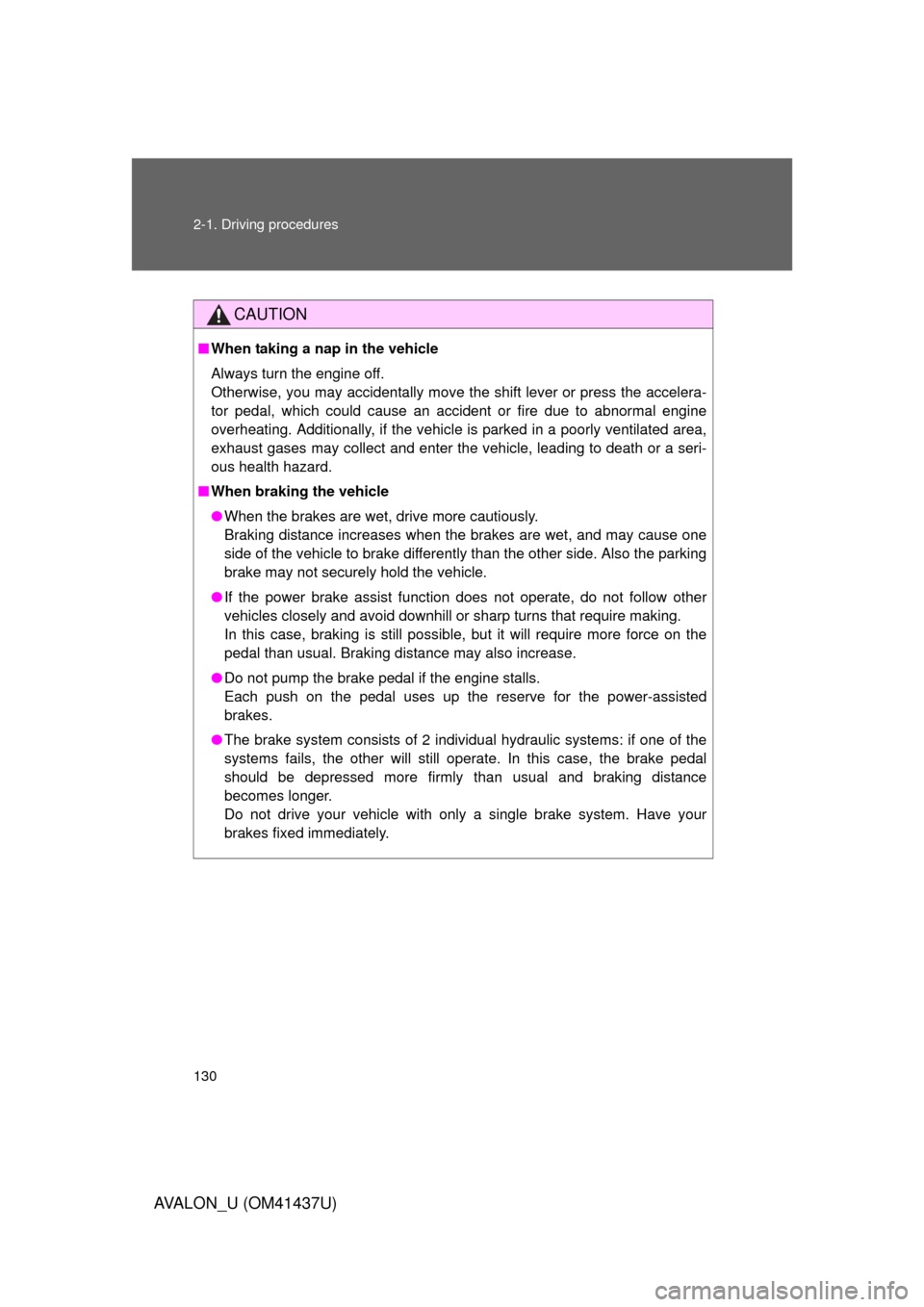
130 2-1. Driving procedures
AVALON_U (OM41437U)
CAUTION
■When taking a nap in the vehicle
Always turn the engine off.
Otherwise, you may accidentally move the shift lever or press the accelera-
tor pedal, which could cause an accident or fire due to abnormal engine
overheating. Additionally, if the vehicle is parked in a poorly ventilated area,
exhaust gases may collect and enter the vehicle, leading to death or a seri-
ous health hazard.
■ When braking the vehicle
● When the brakes are wet, drive more cautiously.
Braking distance increases when the brakes are wet, and may cause one
side of the vehicle to brake differently than the other side. Also the parking
brake may not securely hold the vehicle.
● If the power brake assist function does not operate, do not follow other
vehicles closely and avoid downhill or sharp turns that require making.
In this case, braking is still possible, but it will require more force on the
pedal than usual. Braking distance may also increase.
● Do not pump the brake pedal if the engine stalls.
Each push on the pedal uses up the reserve for the power-assisted
brakes.
● The brake system consists of 2 individual hydraulic systems: if one of the
systems fails, the other will still operate. In this case, the brake pedal
should be depressed more firmly than usual and braking distance
becomes longer.
Do not drive your vehicle with only a single brake system. Have your
brakes fixed immediately.
Page 131 of 476
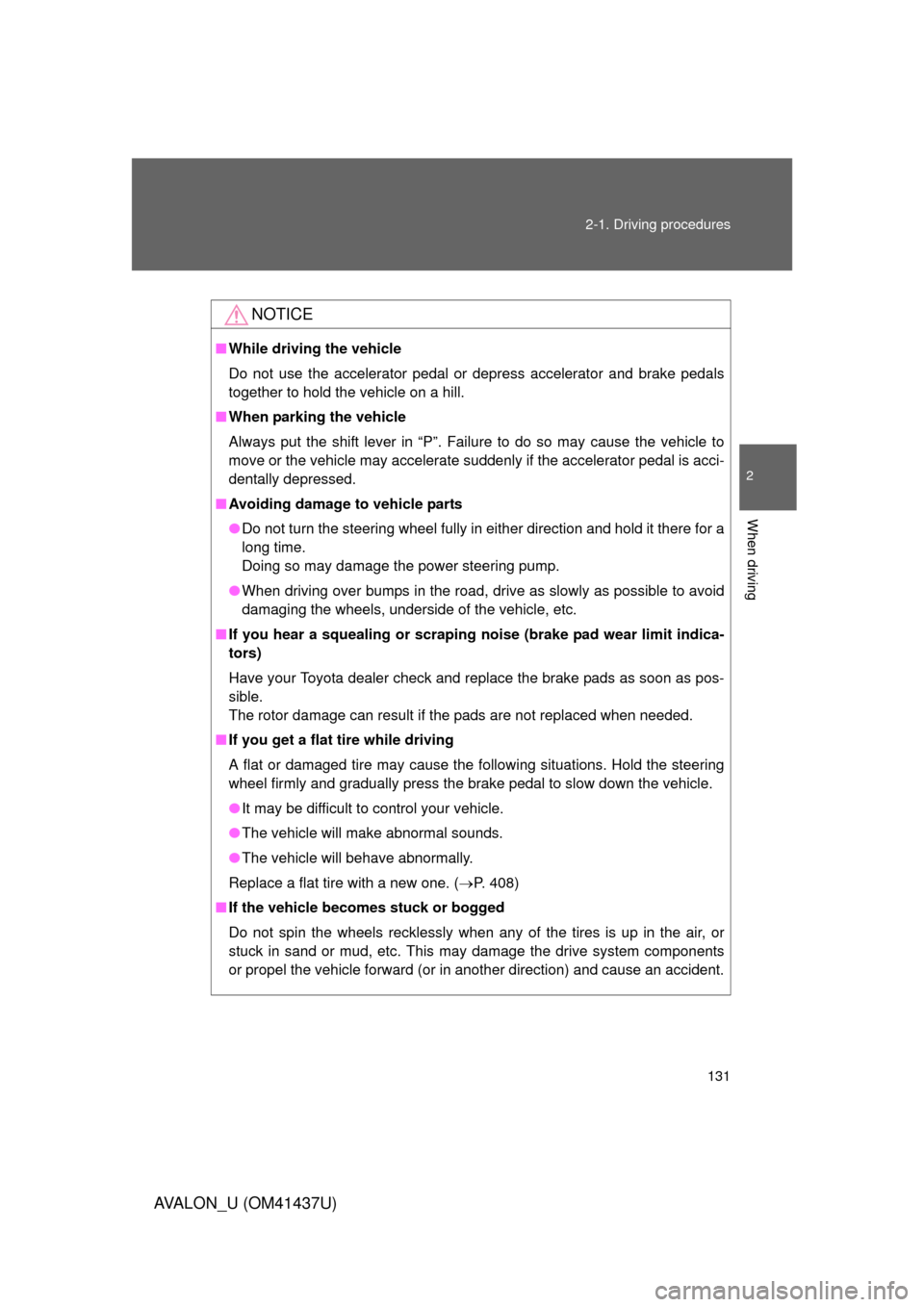
131
2-1. Driving procedures
2
When driving
AVALON_U (OM41437U)
NOTICE
■
While driving the vehicle
Do not use the accelerator pedal or depress accelerator and brake pedals
together to hold the vehicle on a hill.
■ When parking the vehicle
Always put the shift lever in “P”. Failure to do so may cause the vehicle to
move or the vehicle may accelerate suddenly if the accelerator pedal is acci-
dentally depressed.
■ Avoiding damage to vehicle parts
● Do not turn the steering wheel fully in either direction and hold it there for a
long time.
Doing so may damage the power steering pump.
● When driving over bumps in the road, drive as slowly as possible to avoid
damaging the wheels, underside of the vehicle, etc.
■ If you hear a squealing or scrapin g noise (brake pad wear limit indica-
tors)
Have your Toyota dealer check and replace the brake pads as soon as pos-
sible.
The rotor damage can result if the pads are not replaced when needed.
■ If you get a flat tire while driving
A flat or damaged tire may cause the following situations. Hold the steering
wheel firmly and gradually press the brake pedal to slow down the vehicle.
● It may be difficult to control your vehicle.
● The vehicle will make abnormal sounds.
● The vehicle will behave abnormally.
Replace a flat tire with a new one. ( P. 408)
■ If the vehicle becomes stuck or bogged
Do not spin the wheels recklessly when any of the tires is up in the air, or
stuck in sand or mud, etc. This may damage the drive system components
or propel the vehicle forward (or in another direction) and cause an accident.